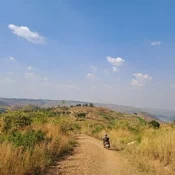You Won’t Forget Anything With Our Uganda Safari Packing List


You Won’t Forget Anything With Our Uganda Safari Packing List
Before you set off on your adventure, it’s essential to ensure you have all the necessary items packed to make your trip safe, comfortable, and enjoyable. In this guide, we will walk you through everything you need to know about packing for a Uganda safari, from essential clothing and gear to health and safety items, and even those often-overlooked miscellaneous items that can make a big difference. So, get ready to prepare for your Uganda safari with confidence and excitement as we delve into the ultimate Uganda safari packing list.
Understanding the Basics: What to Expect on a Uganda Safari
Going on a Uganda safari is an extraordinary adventure that allows you to immerse yourself in the mesmerizing beauty of the country’s wildlife and natural landscapes. Before diving into the packing list, it’s crucial to have a clear understanding of what to expect on a Uganda safari. This section will provide you with valuable information to help you better prepare for your safari experience.
Uganda’s Wildlife and National Parks
Uganda is renowned for its remarkable biodiversity, boasting a wide variety of wildlife species. From the majestic mountain gorillas in Bwindi Impenetrable National Park to the iconic African elephants in Queen Elizabeth National Park, there is no shortage of incredible wildlife encounters. Other notable national parks include Murchison Falls National Park, Kidepo Valley National Park, and Lake Mburo National Park, each offering unique wildlife experiences.
Safari Activities and Excursions
During your Uganda safari, you will have the opportunity to engage in various safari activities and excursions. These may include game drives, where you explore the national parks in search of wildlife sightings, as well as boat safaris, nature walks, and even gorilla trekking. It’s important to research and plan ahead for the specific activities you wish to partake in to ensure you have the appropriate gear and clothing.
Accommodation Options
Uganda offers a range of accommodation options to suit different preferences and budgets. From luxury lodges and tented camps to budget-friendly guesthouses, there are choices for every type of traveler. It’s advisable to book your accommodations in advance, especially during peak seasons, to secure your preferred lodging and ensure a comfortable stay.
Climate and Weather
Understanding Uganda’s climate and weather patterns is vital when packing for your safari. The country experiences two primary seasons: the dry season and the wet season. The dry season, which runs from December to February and June to September, is generally the best time for safaris as wildlife is more concentrated around water sources. The wet season, from March to May and October to November, brings lush green landscapes but also occasional rainfall. Be sure to pack appropriate clothing and gear based on the season you will be visiting.
Cultural Etiquette and Local Customs
While exploring Uganda, it’s important to respect the local culture and customs. The Ugandan people are known for their warm hospitality, and it’s essential to reciprocate this kindness. Familiarize yourself with basic cultural etiquette, such as greeting locals with a handshake and dressing modestly when visiting communities or religious sites. Learning a few basic phrases in the local language, such as greetings and thank you, can also go a long way in building rapport with the locals.
By understanding the basics of what to expect on a Uganda safari, you can better prepare for your journey and ensure a smooth and enjoyable experience. Now that you have a solid foundation, let’s move on to the next section, which covers the essential clothing items you should pack for your safari adventure.
Essential Clothing for a Uganda Safari
When packing for a Uganda safari, choosing the right clothing is crucial to ensure your comfort and safety throughout the journey. In this section, we will discuss the essential clothing items you should pack, taking into consideration the specific requirements of a safari in Uganda.
Why the Correct Clothing is Crucial
The correct clothing is essential for a Uganda safari for several reasons. Firstly, it helps protect you from the elements, such as sun exposure, insects, and potential thorny vegetation. Secondly, appropriate clothing can enhance your overall safari experience, allowing you to blend in with the natural environment and wildlife. Lastly, it contributes to your safety by minimizing the risk of injury or discomfort during activities like bushwalks or gorilla trekking.
Clothing Items to Pack
- Long-sleeved Shirts and T-shirts: Opt for lightweight, breathable shirts with long sleeves to protect your arms from the sun and insect bites. Neutral colors like khaki, beige, or olive green are recommended for blending into the surroundings.
- Lightweight Pants and Shorts: Pack a combination of long pants and shorts made from quick-drying, lightweight materials. Long pants are essential for protection against insects and thorny vegetation, while shorts are suitable for warmer days or relaxing at the lodge.
- Safari Vest or Jacket: A safari vest or lightweight jacket with multiple pockets is ideal for carrying essentials like a camera, sunscreen, and insect repellent. It provides easy access to your belongings while keeping your hands free.
- Rain Jacket or Poncho: Given Uganda’s unpredictable weather, it’s wise to pack a compact, waterproof rain jacket or poncho to stay dry during sudden showers.
- Swimsuit: If your itinerary includes activities near water bodies or lodges with swimming pools, don’t forget to pack a swimsuit.
- Wide-brimmed Hat: Protect your face and neck from the sun by wearing a wide-brimmed hat. It also helps to keep you cool during hot days.
- Safari Boots or Sturdy Walking Shoes: Invest in a good pair of safari boots or sturdy walking shoes with ankle support. These will provide comfort and stability during game drives, nature walks, and gorilla trekking.
- Socks: Pack several pairs of moisture-wicking socks to keep your feet dry and reduce the risk of blisters.
- Undergarments: Don’t forget to pack an ample supply of underwear and bras suitable for the climate and activities.
Weather-specific Clothing Considerations
It’s important to consider the weather conditions during your Uganda safari and pack accordingly. Here are a few additional clothing items to consider based on the season:
- Dry Season (December-February, June-September): During these months, the weather is generally warm and dry. However, temperatures can drop during early morning game drives or at higher altitudes. Pack a lightweight sweater or fleece jacket for layering.
- Wet Season (March-May, October-November): The wet season brings occasional rainfall and cooler temperatures. In addition to your regular safari clothing, pack a lightweight, packable rain jacket and a pair of waterproof pants.
By packing the right clothing for your Uganda safari, you’ll be well-prepared to handle the varying weather conditions and enjoy a comfortable and safe adventure. In the next section, we will discuss important gear and accessories to enhance your safari experience.
Important Gear and Accessories for a Uganda Safari
To make the most of your Uganda safari experience, it’s essential to have the right gear and accessories at hand. In this section, we will explore the important items you should pack to enhance your safari adventure.
Essential Safari Equipment
- Binoculars: A good pair of binoculars is essential for spotting distant wildlife and enjoying a closer view of birds. Opt for lightweight, compact binoculars with good magnification and a wide field of view.
- Headlamp or Flashlight: A reliable headlamp or flashlight is crucial for navigating your surroundings during early morning or evening activities. Make sure to pack extra batteries or consider a rechargeable option.
- Power Bank and Universal Adapter: Keep your electronic devices charged with a power bank and pack a universal adapter to ensure compatibility with Uganda’s electrical outlets.
- Water Bottle: Stay hydrated throughout your safari by carrying a sturdy, reusable water bottle. Look for one with good insulation to keep your water cool in the African heat.
- Daypack or Camera Bag: A small daypack or camera bag will come in handy for carrying your essentials during game drives, walks, or excursions. Ensure it is comfortable and can accommodate your camera, binoculars, water bottle, and other personal items.
Choosing the Right Footwear
- Safari Boots: As mentioned earlier, investing in a pair of sturdy safari boots with ankle support is highly recommended. They provide stability and protection, especially during bushwalks or hikes.
- Comfortable Walking Shoes: In addition to safari boots, pack a pair of comfortable walking shoes for leisurely activities or relaxed days at the lodge.
Camera Equipment for Wildlife Photography
- Digital Camera or DSLR: Capture the incredible wildlife encounters with a digital camera or DSLR. Ensure you are familiar with its features and settings before your safari.
- Telephoto Lens: To get close-up shots of wildlife, particularly birds and distant animals, consider renting or bringing a telephoto lens with a focal length of 200mm or more.
- Memory Cards and Extra Batteries: Bring multiple memory cards with sufficient storage capacity and extra camera batteries to avoid running out of space or power during your safari.
- Camera Cleaning Kit: Keep your camera equipment in optimal condition by packing a cleaning kit that includes a blower, lens cleaning solution, microfiber cloth, and a brush.
Remember to respect wildlife and follow park guidelines regarding photography, especially when it comes to endangered species like gorillas.
By having the right gear and accessories, you can fully immerse yourself in the safari experience and capture incredible moments along the way. In the next section, we will discuss the health and safety items you should pack for your Uganda safari.
Health and Safety Items to Pack for a Uganda Safari
Ensuring your health and safety is of utmost importance when embarking on a Uganda safari. In this section, we will cover the essential health and safety items you should pack to protect yourself during your safari adventure.
Recommended Vaccinations and Medications
- Consult with a Healthcare Professional: Before your trip, consult with a healthcare professional or travel clinic to receive up-to-date information on required and recommended vaccinations for Uganda. Common vaccinations include those for yellow fever, typhoid, hepatitis A and B, and tetanus.
- Anti-Malarial Medication: Uganda is a malaria-endemic country, so it’s crucial to take anti-malarial medication as prescribed by your healthcare professional. Start the medication before your trip and continue according to the recommended duration.
- Prescription Medications: If you take any prescription medications, ensure you have an ample supply for the duration of your trip. Carry them in their original packaging, along with a copy of the prescription.
- First Aid Kit: Pack a comprehensive first aid kit that includes adhesive bandages, antiseptic ointment, pain relievers, blister pads, antidiarrheal medication, and any other personal medications or supplies you may require.
First Aid Supplies
- Insect Repellent: Protect yourself from mosquito bites by packing a reliable insect repellent containing DEET or another effective ingredient. Apply it to exposed skin and clothing as directed.
- Sunscreen: Shield your skin from the African sun by packing a broad-spectrum sunscreen with a high SPF. Apply it generously and frequently, especially during outdoor activities.
- Hand Sanitizer: Carry a travel-sized hand sanitizer to maintain hand hygiene, especially when access to water and soap is limited.
- Water Purification Tablets or Filter: While bottled water is readily available, having water purification tablets or a portable water filter as a backup can be useful, especially during outdoor activities.
Miscellaneous Health and Safety Items
- Travel Insurance: It’s strongly recommended to purchase comprehensive travel insurance that covers medical expenses, emergency evacuation, trip cancellation, and personal belongings.
- Copy of Important Documents: Make copies of your passport, travel insurance documents, vaccination records, and other important documents. Keep both physical and digital copies, and leave one set with a trusted person at home.
- Emergency Contact Information: Carry a list of emergency contact numbers, including those of your embassy or consulate, tour operator, and accommodation.
- Personal Hygiene Items: Pack personal hygiene items such as hand wipes, tissues, menstrual products, and any other essentials you may require.
By being prepared with the necessary health and safety items, you can enjoy your Uganda safari with peace of mind. In the next section, we will cover miscellaneous items that are often overlooked but can greatly enhance your safari experience.
Miscellaneous Items to Bring on a Uganda Safari
While packing for a Uganda safari, it’s important not to overlook the miscellaneous items that can greatly enhance your overall experience. In this section, we will explore some often-forgotten but valuable items to consider bringing on your safari adventure.
Travel Documents and Money
- Passport: Ensure your passport is valid for at least six months beyond your intended departure date from Uganda. Carry a photocopy of your passport as a backup.
- Visa: Check the visa requirements for Uganda and obtain the necessary visa prior to your trip. Carry a printed or digital copy of your visa for reference.
- Travel Insurance Documents: Keep a printed or digital copy of your travel insurance documents, including the policy details and emergency contact numbers.
- Cash and Cards: Carry a mix of cash and cards for your financial needs during the safari. While credit cards are accepted in major establishments, it’s advisable to have some local currency (Ugandan shillings) for smaller transactions and tips.
Snacks and Hydration
- Snacks: Pack some lightweight, non-perishable snacks such as energy bars, nuts, or dried fruits to keep you fueled during long drives or excursions.
- Reusable Water Bottle: As mentioned earlier, a reusable water bottle is essential. Consider bringing a bottle with a built-in water filter to ensure access to clean drinking water throughout your safari.
Entertainment for Downtime
- Books or E-Reader: Relax during downtime by bringing a book or an e-reader loaded with your favorite reads.
- Journal and Pen: Capture your safari memories and experiences in a journal. Reflecting on your journey and documenting wildlife sightings can be a wonderful way to cherish the moments.
- Deck of Cards or Travel Games: Pack a deck of cards or compact travel games to enjoy with your fellow safari companions during downtime or evenings at the lodge.
Other Miscellaneous Items
Travel Adapter: Carry a travel adapter suitable for Uganda’s electrical outlets to charge your electronic devices.
Sunglasses: Protect your eyes from the sun’s glare by packing a pair of sunglasses with UV protection.
Travel Pillow and Blanket: For long drives or flights, a travel pillow and lightweight blanket can provide comfort and make your journey more relaxing.
Swiss Army Knife or Multi-tool: A compact Swiss Army Knife or multi-tool can come in handy for various situations, such as cutting fruits or opening packages.
Remember to pack these miscellaneous items based on your personal preferences and needs. They can add convenience, comfort, and entertainment to your Uganda safari experience. In the final section, we will conclude our comprehensive guide and summarize the key points to help you prepare for your unforgettable adventure.
Preparing for Your Uganda Safari
As you conclude your journey through this comprehensive guide, you are now equipped with the knowledge and information necessary to prepare for your unforgettable Uganda safari. By following the packing list and considering the essential clothing, gear, health and safety items, and miscellaneous items, you can ensure a comfortable, safe, and enjoyable adventure.
Remember to research and understand the basics of a Uganda safari, including the wildlife, national parks, activities, accommodations, climate, and local customs. This will help you set realistic expectations and make the most of your experience.
Pay close attention to the clothing section, packing appropriate attire for the weather and activities. Choose gear and accessories that will enhance your safari, such as binoculars, a headlamp, and camera equipment for photography enthusiasts.
Prioritize your health and safety by consulting with a healthcare professional for necessary vaccinations and medications. Pack a well-stocked first aid kit and take precautions against insects and the African sun.
Don’t forget the miscellaneous items that can add convenience and entertainment to your safari, such as travel documents, snacks, entertainment, and other useful items.
Lastly, always practice responsible and respectful tourism. Follow park regulations, respect wildlife, and engage in sustainable safari practices to ensure the preservation of Uganda’s natural treasures for future generations.
Now, with your packing list complete and your preparations in order, it’s time to embark on your Uganda safari adventure. Get ready to witness the breathtaking beauty of the country’s wildlife, connect with nature, and create memories that will last a lifetime. Enjoy your safari experience and cherish every moment in the remarkable land of Uganda. Safe travels!




